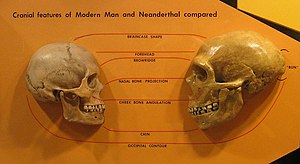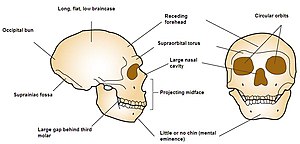Neanderthal
 From Wikipedia the free encyclopedia
From Wikipedia the free encyclopedia
This article may be too long to read and navigate comfortably. When this tag was added, its readable prose size was 16,000 words. (September 2024) |
| Neanderthal Temporal range: Middle to Late Pleistocene | |
|---|---|
 | |
| An approximate reconstruction of a Neanderthal skeleton. The central rib-cage (including the sternum) and parts of the pelvis are from modern humans. | |
| Scientific classification | |
| Domain: | Eukaryota |
| Kingdom: | Animalia |
| Phylum: | Chordata |
| Class: | Mammalia |
| Order: | Primates |
| Suborder: | Haplorhini |
| Infraorder: | Simiiformes |
| Family: | Hominidae |
| Subfamily: | Homininae |
| Tribe: | Hominini |
| Genus: | Homo |
| Species: | †H. neanderthalensis |
| Binomial name | |
| †Homo neanderthalensis King, 1864 | |
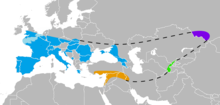 | |
| Known Neanderthal range in Europe (blue), Southwest Asia (orange), Uzbekistan (green), and the Altai Mountains (violet) | |
| Synonyms[6] | |
| Homo
Palaeoanthropus Protanthropus
| |
Neanderthals (/niˈændərˌtɑːl, neɪ-, -ˌθɑːl/ nee-AN-də(r)-TAHL, nay-, -THAHL;[7] Homo neanderthalensis or H. sapiens neanderthalensis) are an extinct group of archaic humans (generally regarded as a distinct species, though some regard it as a subspecies of Homo sapiens) who lived in Eurasia until about 40,000 years ago.[8][9][10][11] The type specimen, Neanderthal 1, was found in 1856 in the Neander Valley in present-day Germany.
It is not clear when the line of Neanderthals split from that of modern humans; studies have produced various times ranging from 315,000[12] to more than 800,000 years ago.[13] The date of divergence of Neanderthals from their ancestor H. heidelbergensis is also unclear. The oldest potential Neanderthal bones date to 430,000 years ago, but the classification remains uncertain.[14] Neanderthals are known from numerous fossils, especially from after 130,000 years ago.[15]
The reasons for Neanderthal extinction are disputed.[16][17] Theories for their extinction include demographic factors such as small population size and inbreeding, competitive replacement,[18] interbreeding and assimilation with modern humans,[19] change of climate,[20][21][22] disease,[23][24] or a combination of these factors.[22] Neanderthals lived in a high-stress environment with high trauma rates, and about 80% died before the age of 40.[25] The total population of Neanderthals remained low, and interbreeding with humans tended toward a loss of Neanderthal genes over time.[26] They lacked effective long-distance networks. Despite this, there is evidence of regional cultures and regular communication between communities,[27][28] possibly moving between caves seasonally.[29]
For much of the early 20th century, European researchers depicted Neanderthals as primitive, unintelligent and brutish. Although knowledge and perception of them has markedly changed since then in the scientific community, the image of the unevolved caveman archetype remains prevalent in popular culture.[30][31] In truth, Neanderthal technology was quite sophisticated. It includes the Mousterian stone-tool industry[32][33] as well as the abilities to create fire,[34][35] build cave hearths[36][37] (to cook food, keep warm, defend themselves from animals, placing it at the centre of their homes),[38] make adhesive birch bark tar,[39] craft at least simple clothes similar to blankets and ponchos,[40] weave,[41] go seafaring through the Mediterranean,[42][43] make use of medicinal plants,[44][45][46] treat severe injuries,[47] store food,[48] and use various cooking techniques such as roasting, boiling,[49] and smoking.[50]
Neanderthals consumed a wide array of food, mainly hoofed mammals,[51] but also megafauna,[30][52] plants,[53][54][55] small mammals, birds, and aquatic and marine resources.[56] Although they were probably apex predators, they still competed with cave lions, cave hyenas and other large predators.[57] A number of examples of symbolic thought and Palaeolithic art have been inconclusively[58] attributed to Neanderthals, namely possible ornaments made from bird claws and feathers,[59][60] shells,[61] collections of unusual objects including crystals and fossils,[62] engravings,[63] music production (possibly indicated by the Divje Babe flute),[64] and Spanish cave paintings contentiously[65] dated to before 65,000 years ago.[66][67] Some claims of religious beliefs have been made.[68] Neanderthals were likely capable of speech, possibly articulate, although the complexity of their language is not known.[69][70]
Compared with modern humans, Neanderthals had a more robust build and proportionally shorter limbs. Researchers often explain these features as adaptations to conserve heat in a cold climate, but they may also have been adaptations for sprinting in the warmer, forested landscape that Neanderthals often inhabited.[71] They had cold-specific adaptations, such as specialised body-fat storage[72] and an enlarged nose to warm air[73] (although the nose could have been caused by genetic drift[74]). Average Neanderthal men stood around 165 cm (5 ft 5 in) and women 153 cm (5 ft 0 in) tall, similar to pre-industrial modern Europeans.[75] The braincases of Neanderthal men and women averaged about 1,600 cm3 (98 cu in) and 1,300 cm3 (79 cu in), respectively,[76][77][78] which is considerably larger than the modern human average (1,260 cm3 (77 cu in) and 1,130 cm3 (69 cu in), respectively).[79] The Neanderthal skull was more elongated and the brain had smaller parietal lobes[80][81][82] and cerebellum,[83][84] but larger temporal, occipital and orbitofrontal regions.[85][86]
The 2010 Neanderthal genome project's draft report presented evidence for interbreeding between Neanderthals and modern humans.[87][88][89] It possibly occurred 316,000 to 219,000 years ago,[90] but more likely 100,000 years ago and again 65,000 years ago.[91] Neanderthals also appear to have interbred with Denisovans, a different group of archaic humans, in Siberia.[92][93] Around 1–4% of genomes of Eurasians, Indigenous Australians, Melanesians, Native Americans and North Africans is of Neanderthal ancestry, while most inhabitants of sub-Saharan Africa have around 0.3% of Neanderthal genes, save possible traces from early sapiens-to-Neanderthal gene flow and/or more recent back-migration of Eurasians to Africa. In all, about 20% of distinctly Neanderthal gene variants survive in modern humans.[94] Although many of the gene variants inherited from Neanderthals may have been detrimental and selected out,[26] Neanderthal introgression appears to have affected the modern human immune system,[95][96][97][98] and is also implicated in several other biological functions and structures,[99] but a large portion appears to be non-coding DNA.[100]
Taxonomy
[edit]Etymology
[edit]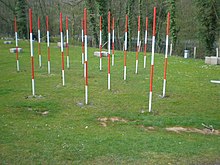
Neanderthals are named after the Neander Valley in which the first identified specimen was found. The valley was spelled Neanderthal and the species was spelled Neanderthaler in German until the spelling reform of 1901.[b] The spelling Neandertal for the species is occasionally seen in English, even in scientific publications, but the scientific name, H. neanderthalensis, is always spelled with th according to the principle of priority. The vernacular name of the species in German is always Neandertaler ("inhabitant of the Neander Valley"), whereas Neandertal always refers to the valley.[c] The valley itself was named after the late 17th century German theologian and hymn writer Joachim Neander, who often visited the area.[101] His name in turn means 'new man', being a learned Graecisation of the German surname Neumann.
Neanderthal can be pronounced using the /t/ (as in /niˈændərtɑːl/)[104] or the standard English pronunciation of th with the fricative /θ/ (as /niˈændərθɔːl/).[105][106] The latter pronunciation, nevertheless, has no basis in the original German word which is pronounced always with a t regardless of the historical spelling.
Neanderthal 1, the type specimen, was known as the "Neanderthal cranium" or "Neanderthal skull" in anthropological literature, and the individual reconstructed on the basis of the skull was occasionally called "the Neanderthal man".[107] The binomial name Homo neanderthalensis—extending the name "Neanderthal man" from the individual specimen to the entire species, and formally recognising it as distinct from humans—was first proposed by Irish geologist William King in a paper read to the 33rd British Science Association in 1863.[108][109][110] However, in 1864, he recommended that Neanderthals and modern humans be classified in different genera as he compared the Neanderthal braincase to that of a chimpanzee and argued that they were "incapable of moral and [theistic[d]] conceptions".[111]
Research history
[edit]

The first Neanderthal remains—Engis 2 (a skull)—were discovered in 1829 by Dutch/Belgian prehistorian Philippe-Charles Schmerling in the Grottes d'Engis, Belgium. He concluded that these "poorly developed" human remains must have been buried at the same time and by the same causes as the co-existing remains of extinct animal species.[112] In 1848, Gibraltar 1 from Forbes' Quarry was presented to the Gibraltar Scientific Society by their Secretary Lieutenant Edmund Henry Réné Flint, but was thought to be a modern human skull.[113] In 1856, local schoolteacher Johann Carl Fuhlrott recognised bones from Kleine Feldhofer Grotte in Neander Valley—Neanderthal 1 (the holotype specimen)—as distinct from modern humans,[e] and gave them to German anthropologist Hermann Schaaffhausen to study in 1857. It comprised the cranium, thigh bones, right arm, left humerus and ulna, left ilium (hip bone), part of the right shoulder blade, and pieces of the ribs.[111][114]
Following Charles Darwin's On the Origin of Species, Fuhlrott and Schaaffhausen argued the bones represented an ancient modern human form;[31][111][115][116] Schaaffhausen, a social Darwinist, believed that humans linearly progressed from savage to civilised, and so concluded that Neanderthals were barbarous cave-dwellers.[31] Fuhlrott and Schaaffhausen met opposition namely from the prolific pathologist Rudolf Virchow who argued against defining new species based on only a single find. In 1872, Virchow erroneously interpreted Neanderthal characteristics as evidence of senility, disease and malformation instead of archaicness,[117] which stalled Neanderthal research until the end of the century.[31][115]
By the early 20th century, numerous other Neanderthal discoveries were made, establishing H. neanderthalensis as a legitimate species. The most influential specimen was La Chapelle-aux-Saints 1 ("The Old Man") from La Chapelle-aux-Saints, France. French palaeontologist Marcellin Boule authored several publications, among the first to establish palaeontology as a science, detailing the specimen, but reconstructed him as slouching, ape-like, and only remotely related to modern humans.
The 1912 'discovery' of Piltdown Man (a hoax), appearing much more similar to modern humans than Neanderthals, was used as evidence that multiple different and unrelated branches of primitive humans existed, and supported Boule's reconstruction of H. neanderthalensis as a far distant relative and an evolutionary dead-end.[31][118][119][120] He fuelled the popular image of Neanderthals as barbarous, slouching, club-wielding primitives; this image was reproduced for several decades and popularised in science fiction works, such as the 1911 The Quest for Fire by J.-H. Rosny aîné and the 1927 The Grisly Folk by H. G. Wells in which they are depicted as monsters.[31] In 1911, Scottish anthropologist Arthur Keith reconstructed La Chapelle-aux-Saints 1 as an immediate precursor to modern humans, sitting next to a fire, producing tools, wearing a necklace, and having a more humanlike posture, but this failed to garner much scientific rapport, and Keith later abandoned his thesis in 1915.[31][115][121]
By the middle of the century, based on the exposure of Piltdown Man as a hoax as well as a reexamination of La Chapelle-aux-Saints 1 (who had osteoarthritis which caused slouching in life) and new discoveries, the scientific community began to rework its understanding of Neanderthals. Ideas such as Neanderthal behaviour, intelligence and culture were being discussed, and a more humanlike image of them emerged. In 1939, American anthropologist Carleton Coon reconstructed a Neanderthal in a modern business suit and hat to emphasise that they would be, more or less, indistinguishable from modern humans had they survived into the present. William Golding's 1955 novel The Inheritors depicts Neanderthals as much more emotional and civilised.[30][31][120] However, Boule's image continued to influence works until the 1960s. In modern-day, Neanderthal reconstructions are often very humanlike.[115][120]
−10 — – −9 — – −8 — – −7 — – −6 — – −5 — – −4 — – −3 — – −2 — – −1 — – 0 — |
| |||||||||||||||||||||||||||||
Hybridisation between Neanderthals and early modern humans had been suggested early on,[122] such as by English anthropologist Thomas Huxley in 1890,[123] Danish ethnographer Hans Peder Steensby in 1907,[124] and Coon in 1962.[125] In the early 2000s, supposed hybrid specimens were discovered: Lagar Velho 1[126][127][128][129] and Muierii 1.[130] However, similar anatomy could also have been caused by adapting to a similar environment rather than interbreeding.[100]
Neanderthal admixture was found to be present in modern populations in 2010 with the mapping of the first Neanderthal genome sequence.[87] This was based on three specimens in Vindija Cave, Croatia, which contained almost 4% archaic DNA (allowing for near complete sequencing of the genome). However, there was approximately 1 error for every 200 letters (base pairs) based on the implausibly high mutation rate, probably due to the preservation of the sample. In 2012, British-American geneticist Graham Coop hypothesised that they instead found evidence of a different archaic human species interbreeding with modern humans, which was disproven in 2013 by the sequencing of a high-quality Neanderthal genome preserved in a toe bone from Denisova Cave, Siberia.[100]
Classification
[edit]
| |||||||||||||||||||||||||||||||||
| 2019 phylogeny based on comparison of ancient proteomes and genomes with those of modern species.[131] |
Neanderthals are hominids in the genus Homo, humans, and generally classified as a distinct species, H. neanderthalensis, although sometimes as a subspecies of modern human as Homo sapiens neanderthalensis. This would necessitate the classification of modern humans as H. sapiens sapiens.[132]
A large part of the controversy stems from the vagueness of the term "species", as it is generally used to distinguish two genetically isolated populations, but admixture between modern humans and Neanderthals is known to have occurred.[132][133] However, the absence of Neanderthal-derived patrilineal Y-chromosome and matrilineal mitochondrial DNA (mtDNA) in modern humans, along with the underrepresentation of Neanderthal X chromosome DNA, could imply reduced fertility or frequent sterility of some hybrid crosses,[89][134][135][136] representing a partial biological reproductive barrier between the groups, and therefore species distinction.[89] In 2014 geneticist Svante Pääbo summarised the controversy, describing such "taxonomic wars" as unresolvable, "since there is no definition of species perfectly describing the case".[132]
Neanderthals are thought to have been more closely related to Denisovans than to modern humans. Likewise, Neanderthals and Denisovans share a more recent last common ancestor (LCA) than to modern humans, based on nuclear DNA (nDNA). However, Neanderthals and modern humans share a more recent mitochondrial LCA (observable by studying mtDNA) and Y chromosome LCA.[137] This likely resulted from an interbreeding event subsequent to the Neanderthal/Denisovan split. This involved either introgression coming from an unknown archaic human into Denisovans,[92][93][131][138][139] or introgression from an earlier unidentified modern human wave from Africa into Neanderthals.[137][140][141] The fact that the mtDNA of a ~430,000 years old early Neanderthal-line archaic human from Sima de los Huesos in Spain is more closely related to those of Denisovans than to other Neanderthals or modern humans has been cited as evidence in favour of the latter hypothesis.[137][14][140]
Evolution
[edit]It is largely thought that H. heidelbergensis was the last common ancestor of Neanderthals, Denisovans and modern humans before populations became isolated in Europe, Asia and Africa, respectively.[142] The taxonomic distinction between H. heidelbergensis and Neanderthals is mostly based on a fossil gap in Europe between 300 and 243,000 years ago during marine isotope stage 8. "Neanderthals", by convention, are fossils which date to after this gap.[12][30][143] DNA from archaic humans from the 430,000-year-old Sima de los Huesos site in Spain indicate that they are more closely related to Neanderthals than to Denisovans, indicating that the split between Neanderthals and Denisovans must predate this time.[14][144][145] The 400,000-year-old Aroeira 3 skull may also represent an early member of the Neanderthal line.[146] It is possible that gene flow between Western Europe and Africa during the Middle Pleistocene, may have obscured Neanderthal characteristics in some Middle Pleistocene European hominin specimens, such those from Ceprano, Italy, and Sićevo Gorge, Serbia.[14] The fossil record is much more complete from 130,000 years ago onwards,[147] and specimens from this period make up the bulk of known Neanderthal skeletons.[148][149] Dental remains from the Italian Visogliano and Fontana Ranuccio sites indicate that Neanderthal dental features had evolved by around 450–430,000 years ago during the Middle Pleistocene.[150]
There are two main hypotheses regarding the evolution of Neanderthals following the Neanderthal/human split: two-phase and accretion. Two-phase argues that a single major environmental event—such as the Saale glaciation—caused European H. heidelbergensis to increase rapidly in body size and robustness, as well as undergoing a lengthening of the head (phase 1), which then led to other changes in skull anatomy (phase 2).[128] However, Neanderthal anatomy may not have been driven entirely by adapting to cold weather.[71] Accretion holds that Neanderthals slowly evolved over time from the ancestral H. heidelbergensis, divided into four stages: early-pre-Neanderthals (MIS 12, Elster glaciation), pre-Neanderthals (MIS 11–9, Holstein interglacial), early Neanderthals (MIS 7–5, Saale glaciation–Eemian), and classic Neanderthals (MIS 4–3, Würm glaciation).[143]
Numerous dates for the Neanderthal/human split have been suggested. The date of around 250,000 years ago cites "H. helmei" as being the last common ancestor (LCA), and the split is associated with the Levallois technique of making stone tools. The date of about 400,000 years ago uses H. heidelbergensis as the LCA. Estimates of 600,000 years ago assume that "H. rhodesiensis" was the LCA, which split off into modern human lineage and a Neanderthal/H. heidelbergensis lineage.[151] Eight hundred thousand years ago has H. antecessor as the LCA, but different variations of this model would push the date back to 1 million years ago.[14][151] However, a 2020 analysis of H. antecessor enamel proteomes suggests that H. antecessor is related but not a direct ancestor.[152] DNA studies have yielded various results for the Neanderthal/human divergence time, such as 538–315,[12] 553–321,[153] 565–503,[154] 654–475,[151] 690–550,[155] 765–550,[14][92] 741–317,[156] and 800–520,000 years ago;[157] and a dental analysis concluded before 800,000 years ago.[13]
Neanderthals and Denisovans are more closely related to each other than they are to modern humans, meaning the Neanderthal/Denisovan split occurred after their split with modern humans.[14][92][138][158] Assuming a mutation rate of 1 × 10−9 or 0.5 × 10−9 per base pair (bp) per year, the Neanderthal/Denisovan split occurred around either 236–190,000 or 473–381,000 years ago, respectively.[92] Using 1.1 × 10−8 per generation with a new generation every 29 years, the time is 744,000 years ago. Using 5 × 10−10 nucleotide sites per year, it is 616,000 years ago. Using the latter dates, the split had likely already occurred by the time hominins spread out across Europe, and unique Neanderthal features had begun evolving by 600–500,000 years ago.[138] Before splitting, Neanderthal/Denisovans (or "Neandersovans") migrating out of Africa into Europe apparently interbred with an unidentified "superarchaic" human species who were already present there; these superarchaics were the descendants of a very early migration out of Africa around 1.9 mya.[159]
Demographics
[edit]Range
[edit]
Pre- and early Neanderthals, living before the Eemian interglacial (130,000 years ago), are poorly known and come mostly from Western European sites. From 130,000 years ago onwards, the quality of the fossil record increases dramatically with classic Neanderthals, who are recorded from Western, Central, Eastern and Mediterranean Europe,[15] as well as Southwest, Central and Northern Asia up to the Altai Mountains in southern Siberia. Pre- and early Neanderthals, on the other hand, seem to have continuously occupied only France, Spain and Italy, although some appear to have moved out of this "core-area" to form temporary settlements eastward (although without leaving Europe). Nonetheless, southwestern France has the highest density of sites for pre-, early and classic Neanderthals.[160] The Neanderthals were the first human species to permanently occupy Europe as the continent was only sporadically occupied by earlier humans.[161]
The southernmost find was recorded at Shuqba Cave, Levant;[162] reports of Neanderthals from the North African Jebel Irhoud[163] and Haua Fteah[164] have been reidentified as H. sapiens. Their easternmost presence is recorded at Denisova Cave, Siberia 85°E; the southeast Chinese Maba Man, a skull, shares several physical attributes with Neanderthals, although these may be the result of convergent evolution rather than Neanderthals extending their range to the Pacific Ocean.[165] The northernmost bound is generally accepted to have been 55°N, with unambiguous sites known between 50–53°N, although this is difficult to assess because glacial advances destroy most human remains, and palaeoanthropologist Trine Kellberg Nielsen has argued that a lack of evidence of Southern Scandinavian occupation is (at least during the Eemian interglacial) due to the former explanation and a lack of research in the area.[166][167] Middle Palaeolithic artefacts have been found up to 60°N on the Russian plains,[168][169][170] but these are more likely attributed to modern humans.[171] A 2017 study claimed the presence of Homo at the 130,000-year-old Californian Cerutti Mastodon site in North America,[172] but this is largely considered implausible.[173][174][175]
It is unknown how the rapidly fluctuating climate of the last glacial period (Dansgaard–Oeschger events) impacted Neanderthals, as warming periods would produce more favourable temperatures but encourage forest growth and deter megafauna, whereas frigid periods would produce the opposite.[176] However, Neanderthals may have preferred a forested landscape.[71] Stable environments with mild mean annual temperatures may have been the most suitable Neanderthal habitats.[177] Populations may have peaked in cold but not extreme intervals, such as marine isotope stages 8 and 6 (respectively, 300,000 and 191,000 years ago during the Saale glaciation). It is possible their range expanded and contracted as the ice retreated and grew, respectively, to avoid permafrost areas, residing in certain refuge zones during glacial maxima.[176] In 2021, Israeli anthropologist Israel Hershkovitz and colleagues suggested the 140- to 120,000-year-old Israeli Nesher Ramla remains, which feature a mix of Neanderthal and more ancient H. erectus traits, represent one such source population which recolonised Europe following a glacial period.[178]

Population
[edit]Like modern humans, Neanderthals probably descended from a very small population with an effective population—the number of individuals who can bear or father children—of 3,000 to 12,000 approximately. However, Neanderthals maintained this very low population, proliferating weakly harmful genes due to the reduced effectivity of natural selection.[26][179] Various studies, using mtDNA analysis, yield varying effective populations,[176] such as about 1,000 to 5,000;[179] 5,000 to 9,000 remaining constant;[180] or 3,000 to 25,000 steadily increasing until 52,000 years ago before declining until extinction.[28] Archaeological evidence suggests that there was a tenfold increase in the modern human population in Western Europe during the period of the Neanderthal/modern human transition,[181] and Neanderthals may have been at a demographic disadvantage due to a lower fertility rate, a higher infant mortality rate, or a combination of the two.[182] Estimates giving a total population in the higher tens of thousands[138] are contested.[179] A consistently low population may be explained in the context of the "Boserupian Trap": a population's carrying capacity is limited by the amount of food it can obtain, which in turn is limited by its technology. Innovation increases with population, but if the population is too low, innovation will not occur very rapidly and the population will remain low. This is consistent with the apparent 150,000 year stagnation in Neanderthal lithic technology.[176]
In a sample of 206 Neanderthals, based on the abundance of young and mature adults in comparison to other age demographics, about 80% of them above the age of 20 died before reaching 40. This high mortality rate was probably due to their high-stress environment.[25] However, it has also been estimated that the age pyramids for Neanderthals and contemporary modern humans were the same.[176] Infant mortality was estimated to have been very high for Neanderthals, about 43% in northern Eurasia.[183]
Anatomy
[edit]Build
[edit]Neanderthals had more robust and stockier builds than typical modern humans,[75] wider and barrel-shaped rib cages; wider pelvises;[30][184] and proportionally shorter forearms and forelegs.[71][185]
Based on 45 Neanderthal long bones from 14 men and 7 women, the average height was 164 to 168 cm (5 ft 5 in to 5 ft 6 in) for males and 152 to 156 cm (5 ft 0 in to 5 ft 1 in) for females.[75] For comparison, the average height of 20 males and 10 females Upper Palaeolithic humans is, respectively, 176.2 cm (5 ft 9.4 in) and 162.9 cm (5 ft 4.1 in), although this decreases by 10 cm (4 in) nearer the end of the period based on 21 males and 15 females;[186] and the average in the year 1900 was 163 cm (5 ft 4 in) and 152.7 cm (5 ft 0 in), respectively.[187] The fossil record shows that adult Neanderthals varied from about 147.5 to 177 cm (4 ft 10 in to 5 ft 10 in) in height, although some may have grown much taller (73.8 to 184.8 cm based on footprint length and from 65.8 to 189.3 cm based on footprint width).[188] For Neanderthal weight, samples of 26 specimens found an average of 77.6 kg (171 lb) for males and 66.4 kg (146 lb) for females.[189] Using 76 kg (168 lb), the body mass index for Neanderthal males was calculated to be 26.9–28.2, which in modern humans correlates to being overweight. This indicates a very robust build.[75] The Neanderthal LEPR gene concerned with storing fat and body heat production is similar to that of the woolly mammoth, and so was likely an adaptation for cold climate.[72]

The neck vertebrae of Neanderthals are thicker from the front to the rear and transversely than those of (most) modern humans, leading to stability, possibly to accommodate a different head shape and size.[190] Although the Neanderthal thorax (where the ribcage is) was similar in size to modern humans, the longer and straighter ribs would have equated to a widened mid-lower thorax and stronger breathing in the lower thorax, which are indicative of a larger diaphragm and possibly greater lung capacity.[184][191][192] The lung capacity of Kebara 2 was estimated to have been 9.04 L (2.39 US gal), compared to the average human capacity of 6 L (1.6 US gal) for males and 4.7 L (1.2 US gal) for females. The Neanderthal chest was also more pronounced (expanded front-to-back, or antero-posteriorly). The sacrum (where the pelvis connects to the spine) was more vertically inclined, and was placed lower in relation to the pelvis, causing the spine to be less curved (exhibit less lordosis) and to fold in on itself somewhat (to be invaginated). In modern populations, this condition affects just a proportion of the population, and is known as a lumbarised sacrum.[193] Such modifications to the spine would have enhanced side-to-side (mediolateral) flexion, better supporting the wider lower thorax. It is claimed by some that this feature would be normal for all Homo, even tropically-adapted Homo ergaster or erectus, with the condition of a narrower thorax in most modern humans being a unique characteristic.[184]
Body proportions are usually cited as being "hyperarctic" as adaptations to the cold, because they are similar to those of human populations which developed in cold climates[194]—the Neanderthal build is most similar to that of Inuit and Siberian Yupiks among modern humans[195]—and shorter limbs result in higher retention of body heat.[185][194][196] Nonetheless, Neanderthals from more temperate climates—such as Iberia—still retain the "hyperarctic" physique.[197] In 2019, English anthropologist John Stewart and colleagues suggested Neanderthals instead were adapted for sprinting, because of evidence of Neanderthals preferring warmer wooded areas over the colder mammoth steppe, and DNA analysis indicating a higher proportion of fast-twitch muscle fibres in Neanderthals than in modern humans. He explained their body proportions and greater muscle mass as adaptations to sprinting as opposed to the endurance-oriented modern human physique,[71] as persistence hunting may only be effective in hot climates where the hunter can run prey to the point of heat exhaustion (hyperthermia). They had longer heel bones,[198] reducing their ability for endurance running, and their shorter limbs would have reduced moment arm at the limbs, allowing for greater net rotational force at the wrists and ankles, causing faster acceleration.[71] In 1981, American palaeoanthropologist Erik Trinkaus made note of this alternate explanation, but considered it less likely.[185][199]
Face
[edit]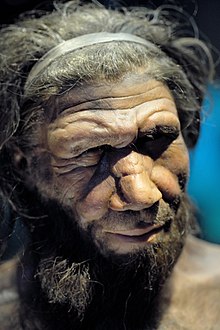
Neanderthals had less developed chins, sloping foreheads, and longer, broader, more projecting noses. The Neanderthal skull is typically more elongated, but also wider, and less globular than that of most modern humans, and features much more of an occipital bun,[200] or "chignon", a protrusion on the back of the skull, although it is within the range of variation for modern humans who have it. It is caused by the cranial base and temporal bones being placed higher and more towards the front of the skull, and a flatter skullcap.[201]
The Neanderthal face is characterised by subnasal[202] as well as mid-facial prognathism, where the zygomatic arches are positioned in a rearward location relative to modern humans, while their maxillary bones and nasal bones are positioned in a more forward direction, by comparison.[203] Neanderthal eyeballs are larger than those of modern humans. One study proposed that this was due to Neanderthals having enhanced visual abilities, at the expense of neocortical and social development.[204] However, this study was rejected by other researchers who concluded that eyeball size does not offer any evidence for the cognitive abilities of Neanderthal or modern humans.[205]
The projected Neanderthal nose and paranasal sinuses have generally been explained as having warmed air as it entered the lungs and retained moisture ("nasal radiator" hypothesis);[206] if their noses were wider, it would differ to the generally narrowed shape in cold-adapted creatures, and that it would have been caused instead by genetic drift. Also, the sinuses reconstructed wide are not grossly large, being comparable in size to those of modern humans. However, if sinus size is not an important factor for breathing cold air, then the actual function would be unclear, so they may not be a good indicator of evolutionary pressures to evolve such a nose.[207] Further, a computer reconstruction of the Neanderthal nose and predicted soft tissue patterns shows some similarities to those of modern Arctic peoples, potentially meaning the noses of both populations convergently evolved for breathing cold, dry air.[73]
Neanderthals featured a rather large jaw which was once cited as a response to a large bite force evidenced by heavy wearing of Neanderthal front teeth (the "anterior dental loading" hypothesis), but similar wearing trends are seen in contemporary humans. It could also have evolved to fit larger teeth in the jaw, which would better resist wear and abrasion,[206][208] and the increased wear on the front teeth compared to the back teeth probably stems from repetitive use. Neanderthal dental wear patterns are most similar to those of modern Inuit.[206] The incisors are large and shovel-shaped, and, compared to modern humans, there was an unusually high frequency of taurodontism, a condition where the molars are bulkier due to an enlarged pulp (tooth core). Taurodontism was once thought to have been a distinguishing characteristic of Neanderthals which lent some mechanical advantage or stemmed from repetitive use, but was more likely simply a product of genetic drift.[209] The bite force of Neanderthals and modern humans is now thought to be about the same,[206] about 285 N (64 lbf) and 255 N (57 lbf) in modern human males and females, respectively.[210]
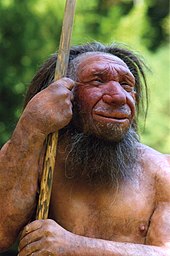
Brain
[edit]The Neanderthal braincase averages 1,640 cm3 (100 cu in) for males and 1,460 cm3 (89 cu in) for females,[77][78] which is significantly larger than the averages for all groups of extant humans;[79] for example, modern European males average 1,362 cm3 (83.1 cu in) and females 1,201 cm3 (73.3 cu in).[211] For 28 modern human specimens from 190,000 to 25,000 years ago, the average was about 1,478 cm3 (90.2 cu in) disregarding sex, and modern human brain size is suggested to have decreased since the Upper Palaeolithic.[212] The largest Neanderthal brain, Amud 1, was calculated to be 1,736 cm3 (105.9 cu in), one of the largest ever recorded in hominids.[78] Both Neanderthal and human infants measure about 400 cm3 (24 cu in).[213]
When viewed from the rear, the Neanderthal braincase has lower, wider, rounder appearance than in anatomically modern humans. This characteristic shape is referred to as "en bombe" (bomb-like), and is unique to Neanderthals, with all other hominid species (including most modern humans) generally having narrow and relatively upright cranial vaults, when viewed from behind.[214][215][216][217] The Neanderthal brain would have been characterised by relatively smaller parietal lobes[85] and a larger cerebellum.[85][218] Neanderthal brains also have larger occipital lobes (relating to the classic occurrence of an occipital bun in Neanderthal skull anatomy, as well as the greater width of their skulls), which implies internal differences in the proportionality of brain-internal regions, relative to Homo sapiens, consistent with external measurements obtained with fossil skulls.[204][219] Their brains also have larger temporal lobe poles,[218] wider orbitofrontal cortex,[220] and larger olfactory bulbs,[221] suggesting potential differences in language comprehension and associations with emotions (temporal functions), decision making (the orbitofrontal cortex) and sense of smell (olfactory bulbs). Their brains also show different rates of brain growth and development.[222] Such differences, while slight, would have been visible to natural selection and may underlie and explain differences in the material record in things like social behaviours, technological innovation and artistic output.[18][223]
Hair and skin colour
[edit]The lack of sunlight most likely led to the proliferation of lighter skin in Neanderthals;[224] however, it has been recently claimed that light skin in modern Europeans was not particularly prolific until perhaps the Bronze Age.[225] Genetically, BNC2 was present in Neanderthals, which is associated with light skin colour; however, a second variation of BNC2 was also present, which in modern populations is associated with darker skin colour in the UK Biobank.[224] DNA analysis of three Neanderthal females from southeastern Europe indicates that they had brown eyes, dark skin colour and brown hair, with one having red hair.[226][227]
In modern humans, skin and hair colour is regulated by the melanocyte-stimulating hormone—which increases the proportion of eumelanin (black pigment) to phaeomelanin (red pigment)—which is encoded by the MC1R gene. There are five known variants in modern humans of the gene which cause loss-of-function and are associated with light skin and hair colour, and another unknown variant in Neanderthals (the R307G variant) which could be associated with pale skin and red hair. The R307G variant was identified in a Neanderthal from Monti Lessini, Italy, and possibly Cueva del Sidrón, Spain.[228] However, as in modern humans, red was probably not a very common hair colour because the variant is not present in many other sequenced Neanderthals.[224]
Metabolism
[edit]Maximum natural lifespan and the timing of adulthood, menopause and gestation were most likely very similar to modern humans.






